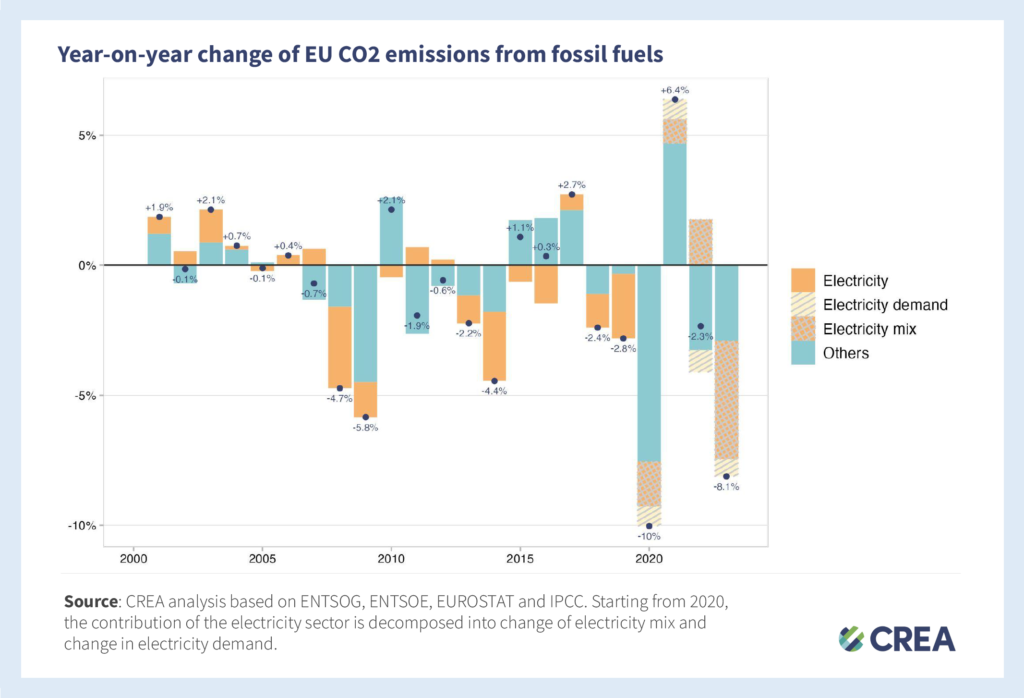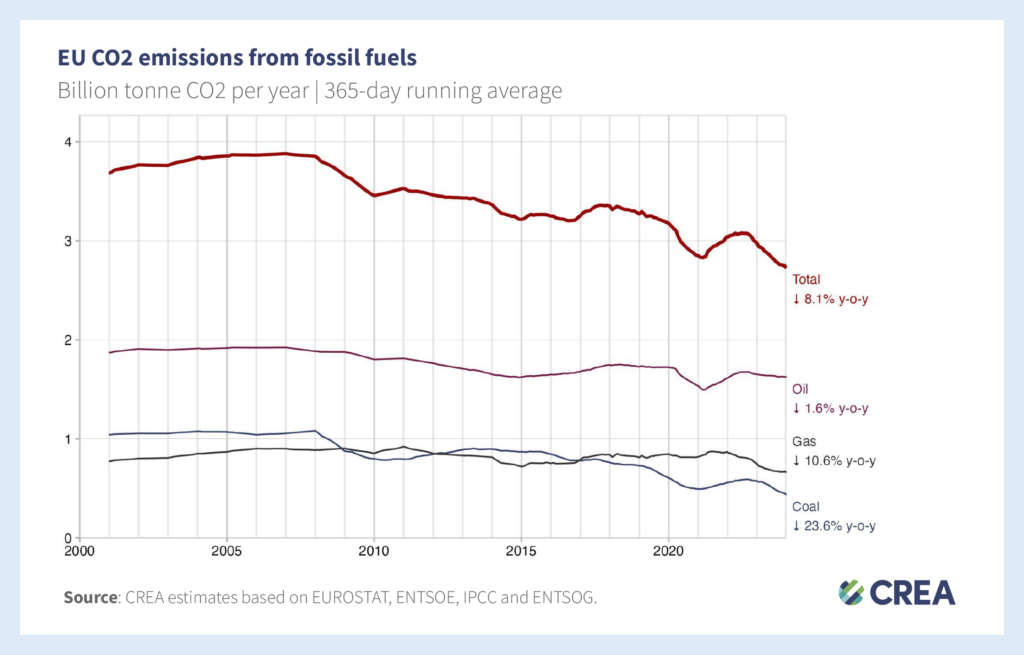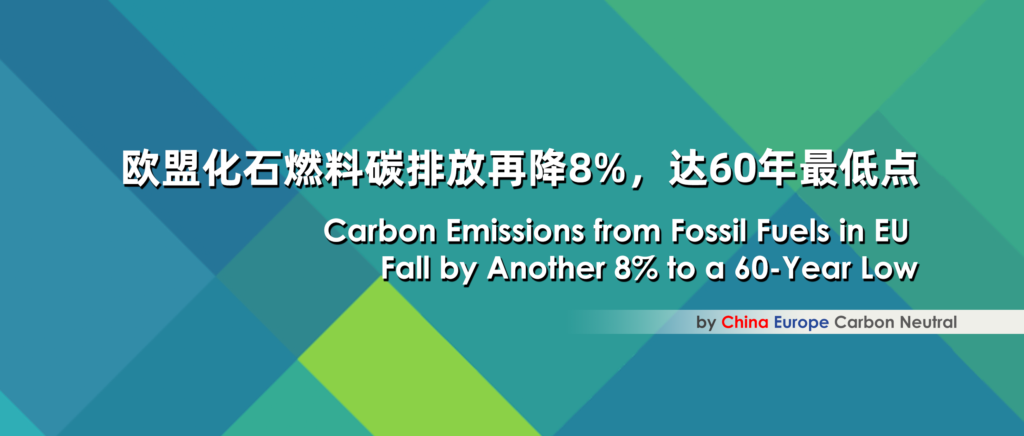近日,CREA机构发布了关于欧盟境内对化石燃料使用的相关调研报告。该报告指出在过去的一年里,欧盟在减少温室气体排放方面进展迅速并取得了骄人的成果。2023年由化石能源产生的温室气体排放量,达到了60年来的最低点。
The Centre for Research on Energy and Clean Air (CREA) has recently released a report on the use of fossil fuels in the European Union (EU), which shows that over the past year, EU has made rapid progress in reducing greenhouse gas emissions. The report shows that EU has made rapid progress in reducing greenhouse gas emissions over the past year, with fossil fuel emissions reaching a 60-year low in 2023.
尽管欧洲的整体经济形势自2020年疫情后受到了较大冲击,但得益于欧盟长期坚持的低碳路线以及相关配套政策的陆续出台,在过去的数年里,欧盟境内的电力结构逐渐走向低碳化,风能、太阳能、水能及核能等可再生能源占比持续上升,发电行业的温室气体排放量同比减少了25%。
Although the overall economic situation in Europe has been greatly affected since the 2020 epidemic, thanks to EU’s long-held low-carbon policies, the power structure in EU has gradually lower its GHG emission in the past few years. With the proportion of renewable energy sources, such as wind, solar, hydropower and nuclear energy continuing to rise, the power generation industry’s GHG emissions have been reduced by 25% year-on-year.

受到2022年开始的俄乌冲突影响,煤炭的消费量在过去几年里有所增长,但在逐渐平衡了市场供需关系,并对使用端进行设备的革新后,2023年欧盟境内煤炭消耗造成的温室气体排放对比2022年下降了25%,对比2015年则减少了45%。与此同时,2023年欧盟境内由天然气消耗产生的温室气体排放也下降了11%。
Coal consumption has increased over the past few years due to the Russian-Ukrainian conflict that began in 2022. After gradually balancing supply and demand in EU and the uses of new technologies, GHG emissions from coal consumption fell by 25% in 2023 compared to 2022, and by 45% compared to 2015. Meanwhile, GHG emissions from natural gas consumption in the EU in 2023 have fallen by 11%.

综合来看,欧盟在过去一年里对于煤炭和天然气的需求正在减少,但对石油的需求并没有太大变化,过去一年里,消耗石油产生的温室气体排放仅比上一年降低了2%。
Taken together, the EU’s demand for coal and natural gas has been declining over the past year, but demand for oil has not changed much, with GHG emissions from oil consumption falling by only 2% over the past year compared to the previous year.
自2023年底,中国政府开始加速推进碳中和布局,各部位在最近一个季度中,陆续出台多项通知文件,要求各级政府积极为企业提供与碳中和相关的便利政策,包括招商引资、企业融资、人才引进、专项减税等在内诸多政策。
Since the end of 2023, the Chinese government has been pushing even harder to promote carbon neutrality. In recent 2 months, several departments of centre government issued guidance and notifications, requesting governments at all levels to actively provide carbon-neutral facilitation policies for enterprises, including policies on investment promotion, enterprise financing, talent introduction, and special tax reductions.
其中,对于引进来自发达国家和地区具有先进减排技术的企业和对技术的学习转化,亦是2024年各级政府的重要任务。
Among them, the introduction of enterprises from developed countries and regions with advanced emission reduction technologies and the learning and transformation of technologies are also important tasks for governments at all levels in 2024.
目前,中国的能源结构仍然以化石能源为主,而目前已确定的2060年实现碳中和这一目标节点,要求中国未来的非化石能源消费比重应达到80%以上。结合目前世界各国家和的确的碳中和推进情况来看,在未来很长一段时间内,中国与欧洲在如何减少碳排放、碳中和技术等相关提议上,将会有很大的合作空间。
At present, China’s energy structure is still dominated by fossil energy, and the goal of achieving carbon neutrality by 2060 has been set, requiring that the proportion of China’s future consumption of non-fossil energy should reach more than 80%. Combined with the current situation of carbon neutrality in various countries and indeed in the world, there will be a great deal of room for cooperation between China and Europe in the long term in terms of how to reduce carbon emissions, carbon neutrality technology, and other related proposals.
如想了解更多信息和更多详情,请联系: [email protected]
For more information and further details please write to: [email protected]
仲欧脱碳科技有限公司中欧碳中和可持续城市发展平台项目将由为此项目成立的同名私营公司运营,旨在通过聚集各方优势,针对每一个课题制定出量身打造的解决方案,以全面和包容的工作方式为中国和欧洲的碳中和之路添砖加瓦。
仲欧脱碳科技 有限公司该平台将发挥积极和创新的作用,为实现碳中和所需的构想、塑造、设计和实现转型提供服务。
China Europe Carbon Neutral Technology aims to support and substantially contribute to China and Europe path towards carbon neutrality in a holistic and inclusive way by gathering all the stakeholders and creating solutions for each challenge.
China Europe Carbon Neutral Technology will play an active and innovative role in providing services to conceive, shape, design and accomplish the transitions needed to achieve carbon neutrality.
